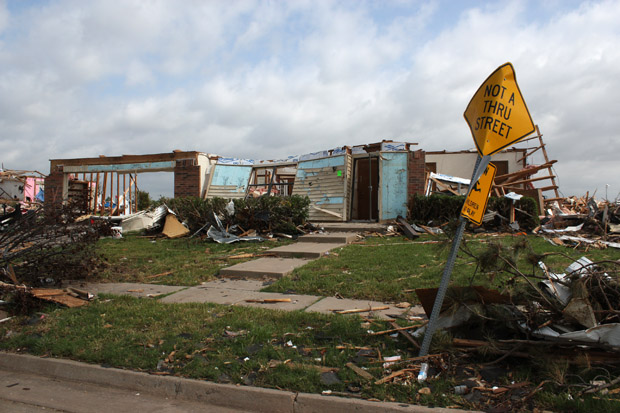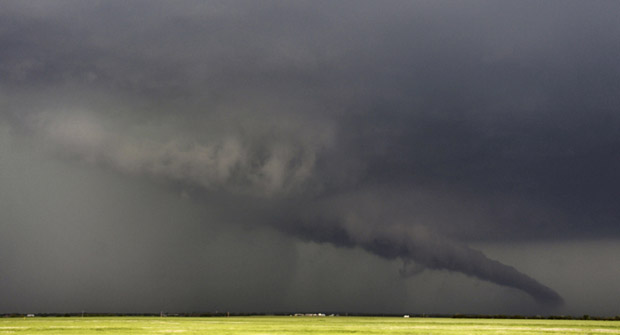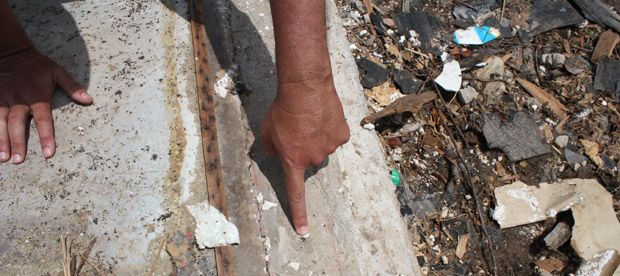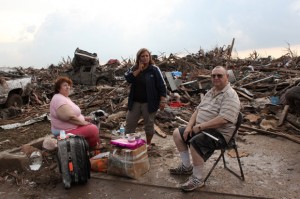
The skeleton of a home on Lakeview Drive in Moore, which was ravaged by the May 20, 2013 tornado.
Joe Wertz / StateImpact Oklahoma


The skeleton of a home on Lakeview Drive in Moore, which was ravaged by the May 20, 2013 tornado.
Joe Wertz / StateImpact Oklahoma

Joe Wertz / StateImpact Oklahoma
The skeleton of a home on Lakeview Drive in Moore, which was ravaged by the May 20, 2013 tornado.
This is part two in our Twister Truths series where we use data to kick the tires on the conventional wisdom underlying severe weather policy in Oklahoma. Read part one here.
Despite the risk that comes with living in Tornado Alley, many Oklahomans are reluctant to build tornado shelters. And state and local building codes don’t factor for twisters.
One reason, researchers say, is a public perception that “nothing can survive an EF5 tornado.” Indeed, it’s hard to imagine any structure outlasting the violent winds and the devastating cloud of shrapnel that accompanies an EF5.
Comments like this one, spotted on a tornado-related story on Gawker’s science blog io9, summarize a common perspective:
“With an F5 tornado you get the ‘house swept away – only foundation is left’ situation – and the only *safe* place from an F5 is underground or out of it’s path. These tornadoes are the ones that literally have pealed up the road where it passed.”
This notion that the worst tornadoes obliterate everything in their path has even factored in some Oklahomans’ deadly decisions to get in their cars and try to outmaneuver storms. In one particularly harrowing story, a mother and her 17-day-old baby were sucked out of their family minivan in the EF5 tornado that carved through the Oklahoma City area on May 31.
But is it true: Can nothing survive an EF5?

Gene Blevins / Reuters/Landov
A massive storm front in May 2013 spawned a swarm of tornadoes, including this one near the Kansas/Oklahoma border.
The question of survivability has two components: People, and the structures they inhabit when severe weather strikes.
But before we tackle that question, it’s important to understand what, exactly, an EF5 tornado is, and how the most severe twisters are categorized.
Directly measuring a tornado’s wind speed is difficult because the storms tend to destroy instruments. So meteorologists have to estimate tornado wind speeds. The original “Fujita Scale” that ranked these estimates was used from 1971 to 2007, but the estimates weren’t really based on actual, measured tornado wind speeds.
So researchers adopted the classification system used today, the “Enhanced Fujita Scale.” That scale, which goes from EF0 to EF5, still uses wind speed estimates, but ones that are based on more-accurate surveys of various tornado-damaged buildings and structures. An EF5 tornado includes gusts of winds of over 200 mph, based on these updated damage assessments.
When an EF5 tornado touches down in habited areas, you can surely expect massive amounts of damage. But just because a tornado meets a meteorological definition of an EF5 storm, it doesn’t necessarily mean you or your house will experience those conditions.
And despite the horrific scenes of tornado destruction that have become all too familiar in Oklahoma, EF5 tornadoes are survivable — both for people and structures. And that has important public policy implications.

Joe Wertz / StateImpact Oklahoma
Tim Marshall, a meteorologist and civil engineer, points at the foundation of a home destroyed in the May 20 tornado in Moore. The home's walls were ripped from the foundation because nails were used instead of bolts.
The “nothing can survive an EF5” myth is a detriment to policies concerning home and commercial building construction, says Timothy Marshall, a meteorologist and a civil engineer at Haag Engineering in Dallas.
“The logic goes: If nothing can survive, why do anything?” Marshall told StateImpact in a July interview.
Just because a tornado is given an EF5 designation doesn’t mean that every structure in its path actually experiences the full brunt of it. In fact, recent research suggests that most structures don’t.
One such study was by Kai Pan, Peter Montpelier and Masoud Zadeh, who analyzed destruction from the May 3, 1999, F5 tornado in Moore. One thing they found was a “damage gradient” that was most severe in the center of the tornado path and less severe near the edge. That’s not surprising, but it’s worth remembering that when we talk about tornado damage: it’s not all or nothing.

Joe Wertz / StateImpact Oklahoma
Stella and Jack Howard (left and right) with their daughter, Dawnelaina (center), sit with the remains of their Moore home. The Howards built this house after their last one was destroyed by the May 3, 1999, twister.
Even homes across the street from each other experienced the effects of the same winds differently, depending on quirks such as whether their garage doors faced the wind or not.
Marshall has studied how buildings withstood the F5 twister that tore through Moore on May 3, 1999 as well as the EF5 on May 20, 2013. What he says seems surprising: Most of the destruction in an EF5 doesn’t come from 200 mph winds, it comes from much weaker winds.
Other research of tornadoes in other states back up Marshall’s observations.
The tornado that killed 162 people and damaged more than 8,000 buildings in Joplin, Mo. in May 2011 provides another example of how, even in the most severe storms, most damage is done by comparatively weak winds.
While Joplin’s tornado was classified as an EF5, no EF5-level damage was found on any of the buildings, according to a study by the American Society of Civil Engineers. Of the 5,000 buildings that were destroyed, most of the damage was done by winds of EF-2 level winds of 135 mph or less, the engineers found.
From The Joplin Globe’s Wally Kennedy:
Had the houses in the tornado zone been built with hurricane ties — metal clips that fasten the rafters and trusses to the exterior walls of a house — the damage would have been much less. It is one of the recommendations coming out of their analysis.
“The study team believes that a relatively large number of buildings could have survived in Joplin if they had been built to withstand hurricane winds,” said Bill Coulbourne, a member of the ASCE engineering team that came to Joplin.
Damage from winds of 135 mph and less is largely preventable. And Marshall says the necessary upgrades are pretty cheap. “Bolts and clips and straps in the proper place… $500-$1,000 on a house, that’s all,” he says.
After surveying the damage in Moore in 1999, Marshall says he told city officials they should upgrade the residential building code to require stronger foundations, hurricane clips and other metal brackets and ties to strengthen walls and roofs.
No changes were made, but city and state officials tell StateImpact stronger construction standards are likely to be enacted after the May 2013 tornadoes in Moore and Oklahoma City.
The EF5 question isn’t just about building codes. It also relates to tornado shelters. As the Gawker commenter above illustrates, many people believe that the destructive power of an EF5 makes an underground shelter the only safe place to go.
That isn’t true. Properly built, above-ground safe rooms — typically a hardened indoor closet or room reinforced with concrete and steel — are just as safe as underground shelters, says Texas Tech’s Ernst Kiesling, who’s also the executive director of the National Storm Shelter Association. In fact, above-ground safe rooms can be safer because they’re more likely to be used when severe storms move in, he says.
“People don’t get into shelters until the last minute, and by that time there’s usually already a lot of wind, rain, hail and, possibly, debris blowing around,” he says. “People look out the window and hesitate, and decide they’ll try to ride it out.”
There have been no reports of any deaths in properly built above-ground safe rooms, Keisling says.
Yet the perception that the only way to survive an EF5 is by seeking refuge in an underground shelter persists. “It’s an untruth that’s very, very damaging, and I wish we could find a way to overcome it,” Kiesling says. “But, unfortunately, once an idea is out there, you can’t kill the idea.”
StateImpact Oklahoma is a partnership among Oklahoma’s public radio stations and produces journalism in the public interest, essential to an informed electorate. Help support informative, in-depth journalism with a donation online.